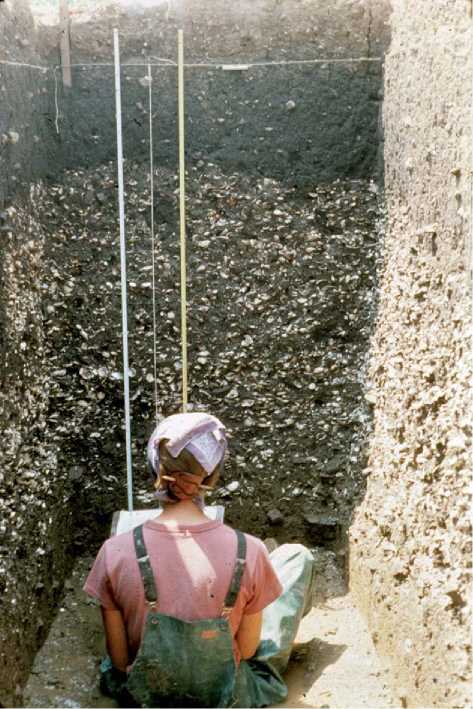Culture historical sequence A chronological ordering of suites of artifacts and events.
Diagnostic artifacts Artifacts that are distinctive in appearance or in other characteristics (e. g., raw material), and that were used only during specific times and places.
Geoarchaeology Archaeological investigations that incorporate geoscientific methods.
Pleistocene A geologic period 1.8million-10000years ago, the Ice Age.
Site formation processes The natural and cultural processes that create and alter archaeological sites by depositing and removing sediments, shell, and artifacts.
Vibracoring A coring machine that uses vibrations to penetrate water-saturated sediments with a hollow tube.
When the tube is pulled out, the sedimentary structures are preserved in the core extracted by, and then extruded from, the tube.
Shell middens are archaeological mounds of refuse containing shell (Figures 1 and 2). They form in coastal and riverine settings where people collect and process shellfish to acquire food, bait, and construction materials, and to manufacture shell tools. A handful of Pleistocene-age shell midden sites have been discovered in the Old World, the earliest of which is 125 000 years old, but most date to after 10 000 years ago. This may be because people more intensely exploited marine resources after the Pleistocene, or because older sites were submerged when sea level rose. Common characteristics of shell middens include low densities of artifacts, high densities of shell, high porosity, and high alkalinity. Current research on these sites addresses a broad range of topics including past human diet, local ecology, climate change, site formation processes, and prehistoric technology.
Archaeological investigations of past human diet at shell middens focus not only on what people ate, but also how and why people exploited shellfish and other marine resources. Researchers study whether human foraging depleted local shellfish populations, and they question whether shellfish were a valued source of protein or a last resort. Archaeologists also address the social organization of shellfishing. Ethnographic evidence suggests that in most cases, collectors were women and children; thus, shell middens are important for exploring their role in past societies.
Another facet of shell midden research reflects increased interest in environmental issues. Since different species of shellfish have different tolerances to environmental factors, archaeologists often track shifts in frequencies of species to investigate change over time in local ecology. They also establish climate chronologies using stable oxygen and carbon isotope compositions in shell to provide evidence on surface water temperature and salinity. From another perspective, researchers use regional spatial analyses of shell middens as well as underwater investigations and vibracoring to track the rise and fall of sea level related to climatic and geologic phenomena. Other geoarchaeological shell midden studies address site formation processes. This research focuses upon processes acting to transport and deposit the shell, artifacts, and sediments to the location, and the alterations by decomposition, compaction, weathering, and leaching.

Figure 1 Excavation of the English Camp shell midden, San Juan Island, Washington.

Figure 2 Excavation of the Carlston Annis mound, Kentucky.
Archaeologists also study the artifacts found at shell midden sites. Past work centered on using diagnostic artifacts to establish culture-historical sequences for sites and regions. Currently, the technological organization of the people who made the artifacts is the focus of research. For example, Bruce Bourque details change over time in material culture at the Turner Farm site in the Gulf of Maine to investigate the relationship between environmental change and human culture. Angela Close reconstructs procurement, manufacture, and discard patterns at a shell midden on the San Juan Islands, Washington to draw interpretations about the social organization and lifeways of the people who lived there.
The above review provides many perspectives from which archaeologists investigate shell midden sites. This diversity reflects the multitude of geologic, chemical, faunal, and cultural data that can be recovered from these sites. Thus, a major theme in recent shell midden studies is interdisciplinary research. For example, William Marquardt and Patty Jo Watson integrate the interdisciplinary research results of a long-term study of agricultural origins in the Eastern Woodlands at shell mounds on the Green River, Kentucky. Synthesis of different lines of evidence allows researchers to test hypotheses more rigorously, and to enrich interpretations of past lifeways.
See also: Caves and Rockshelters; Frozen Sites and Bodies; InvertebrateAnalysis; Paleoenvironmental Reconstruction, Methods; Sites: Mounded and Unmounded; Waterlogged.




 World History
World History









